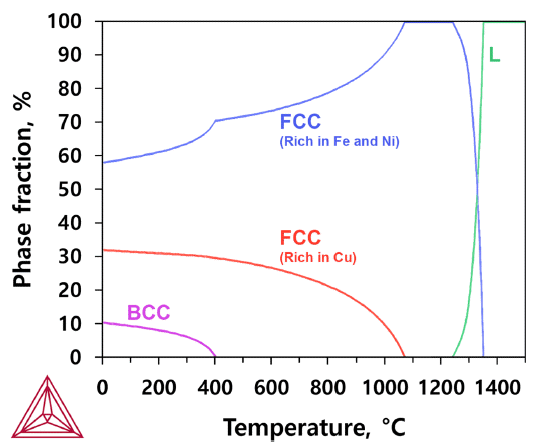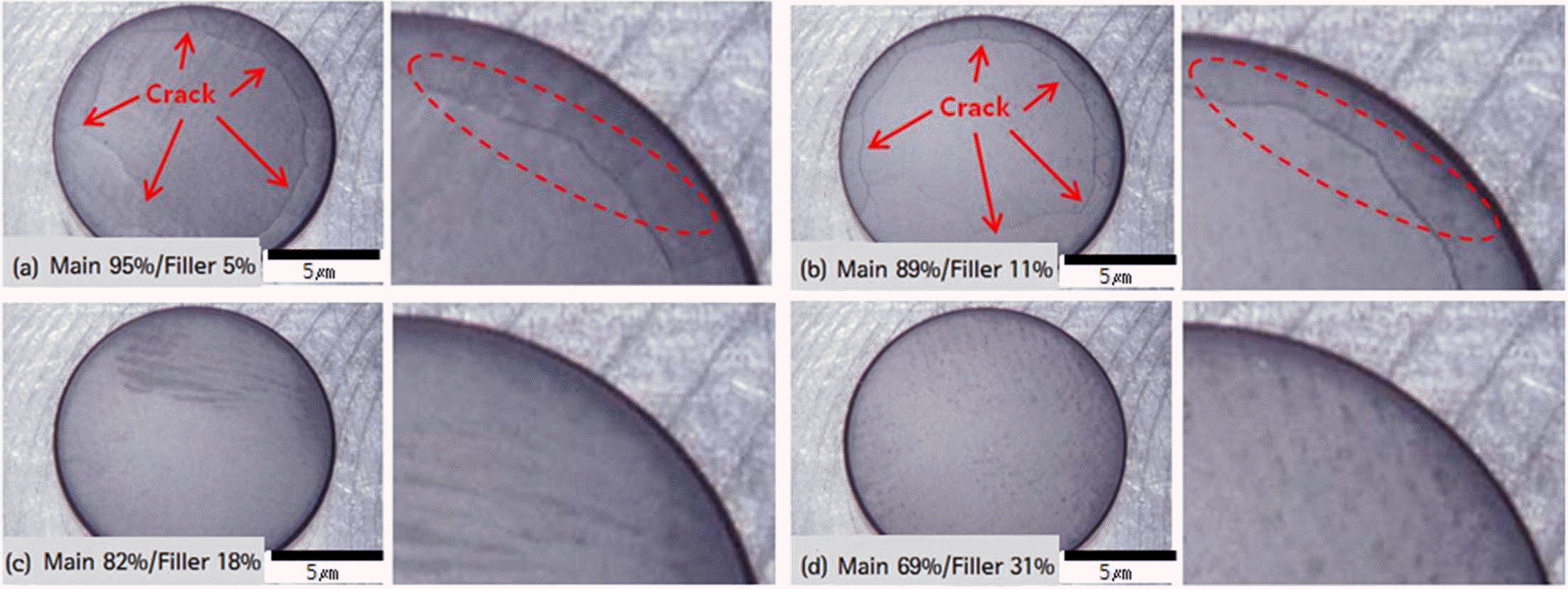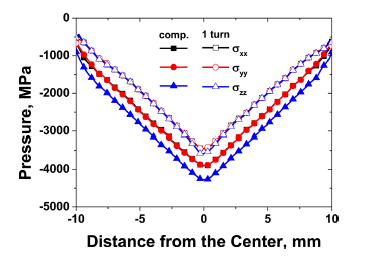Search
- Page Path
- HOME > Search
- [English]
- Fabrication of FeCuNi alloy by mechanical alloying followed by consolidation using high-pressure torsion
- Peyman Asghari-Rad, Yongju Kim, Nhung Thi-Cam Nguyen, Hyoung Seop Kim
- J Korean Powder Metall Inst. 2020;27(1):1-7. Published online February 1, 2020
- DOI: https://doi.org/10.4150/KPMI.2020.27.1.1

- 1,107 View
- 4 Download
- 1 Citations
-
 Abstract
Abstract
 PDF
PDF In this research, a new medium-entropy alloy with an equiatomic composition of FeCuNi was designed using a phase diagram (CALPHAD) technique. The FeCuNi MEA was produced from pure iron, copper, and nickel powders through mechanical alloying. The alloy powders were consolidated via a high-pressure torsion process to obtain a rigid bulk specimen. Subsequently, annealing treatment at different conditions was conducted on the four turn HPT-processed specimen. The microstructural analysis indicates that an ultrafine-grained microstructure is achieved after post-HPT annealing, and microstructural evolutions at various stages of processing were consistent with the thermodynamic calculations. The results indicate that the post-HPT-annealed microstructure consists of a dual-phase structure with two FCC phases: one rich in Cu and the other rich in Fe and Ni. The kernel average misorientation value decreases with the increase in the annealing time and temperature, indicating the recovery of HPT-induced dislocations.
-
Citations
Citations to this article as recorded by- Effects of nickel content and annealing temperature on the magnetic characteristics of nanostructured FeCu alloys
Abderrahmane Younes
Journal of Materials Science: Materials in Electronics.2024;[Epub] CrossRef
- Effects of nickel content and annealing temperature on the magnetic characteristics of nanostructured FeCu alloys
- [English]
- Dispersion Behavior and Size Analysis of Thermally Purified High Pressure-high Temperature Synthesized Nanodiamond Particles
- Hansang Kwon, Jehong Park, Marc Leparoux
- J Korean Powder Metall Inst. 2017;24(3):216-222. Published online June 1, 2017
- DOI: https://doi.org/10.4150/KPMI.2017.24.3.216

- 1,010 View
- 3 Download
- 1 Citations
-
 Abstract
Abstract
 PDF
PDF Synthesized monocrystalline nanodiamond (nD) particles are heat-treated at various temperatures to produce highly structured diamond crystals. The heat-treated nDs show different weight loss ratios during thermogravimetric analysis. The crystallinities of the heat-treated nDs are analyzed using Raman spectroscopy. The average particle sizes of the heat-treated nDs are measured by a dynamic light scattering (DLS) system and direct imaging observation methods. Moreover, individual dispersion behaviors of the heat-treated nD particles are investigated based on ultrasonic dispersion methods. The average particle sizes of the dispersed nDs according to the two different measurement methods show very similar size distributions. Thus, it is possible to produce highly crystallized nD powder particles by a heattreatment process, and the nD particles are relatively easy to disperse individually without any dispersant. The heattreated nDs can lead to potential applications such as in nanocomposites, quantum dots, and biomedical materials.
-
Citations
Citations to this article as recorded by- Two extreme crystal size scales of diamonds, large single crystal and nanocrystal diamonds: Synthesis, properties and their mutual transformation
Yang Wang, Wei-hua Wang, Shi-lin Yang, Guo-yang Shu, Bing Dai, Jia-qi Zhu
New Carbon Materials.2021; 36(3): 512. CrossRef
- Two extreme crystal size scales of diamonds, large single crystal and nanocrystal diamonds: Synthesis, properties and their mutual transformation
- [Korean]
- Effect of Molding Pressure on the Microstructure and Wear Resistance Property of Polycrystalline Diamond Compact
- Ji-Won Kim, Hee-Sub Park, Jin-Hyeon Cho, Kee-Ahn Lee
- J Korean Powder Metall Inst. 2015;22(3):203-207. Published online June 1, 2015
- DOI: https://doi.org/10.4150/KPMI.2015.22.3.203

- 696 View
- 7 Download
- 2 Citations
-
 Abstract
Abstract
 PDF
PDF This study investigated the microstructure and wear resistance property of HPHT (high pressure high temperature) sintered PDC (polycrystalline diamond compact) in accordance with initial molding pressure. After quantifying an identical amount of diamond powder, the powder was inserted in top of WC-Co sintered material, and molded under four different pressure conditions (50, 100, 150, 200 kgf/cm2). The obtained diamond compact underwent sintering in high pressure, high temperature conditions. In the case of the 50 kgf/cm2 initial molding pressure condition, cracks were formed on the surface of PDC. On the other hand, PDCs obtained from 100~200 kgf/cm2 initial molding pressure conditions showed a meticulous structure. As molding pressure increased, low Co composition within PDC was detected. A wear resistance test was performed on the PDC, and the 200 kgf/cm2 condition PDC showed the highest wear resistance property.
-
Citations
Citations to this article as recorded by- Effect of Co Leaching on the Vertical Turning Lathe Wear Properties of Polycrystalline Diamond Compact Manufactured by High Temperature and High Pressure Sintering Process
Min-Seok Baek, Ji-Won Kim, Bae-Gun Park, Hee-Sub Park, Kee-Ahn Lee
Korean Journal of Metals and Materials.2020; 58(7): 480. CrossRef - Enhanced wear resistivity of a Zr-based bulk metallic glass processed by high-pressure torsion under reciprocating dry conditions
Soo-Hyun Joo, Dong-Hai Pi, Jing Guo, Hidemi Kato, Sunghak Lee, Hyoung Seop Kim
Metals and Materials International.2016; 22(3): 383. CrossRef
- Effect of Co Leaching on the Vertical Turning Lathe Wear Properties of Polycrystalline Diamond Compact Manufactured by High Temperature and High Pressure Sintering Process
- [Korean]
- Effect of Diamond Particle Ratio on the Microstructure and Thermal Shock Property of HPHT Sintered Polycrystalline Diamond Compact (PDC)
- Ji-Won Kim, Hee-Sub Park, Jin-Hyeon Cho, Kee-Ahn Lee
- J Korean Powder Metall Inst. 2015;22(2):111-115. Published online April 1, 2015
- DOI: https://doi.org/10.4150/KPMI.2015.22.2.111

- 817 View
- 9 Download
- 3 Citations
-
 Abstract
Abstract
 PDF
PDF This study investigates the microstructure and thermal shock properties of polycrystalline diamond compact (PDC) produced by the high-temperature, high-pressure (HPHT) process. The diamond used for the investigation features a 12~22 μm- and 8~16 μm-sized main particles, and 1~2 μm-sized filler particles. The filler particle ratio is adjusted up to 5~31% to produce a mixed particle, and then the tap density is measured. The measurement finds that as the filler particle ratio increases, the tap density value continuously increases, but at 23% or greater, it reduces by a small margin. The mixed particle described above undergoes an HPHT sintering process. Observation of PDC microstructures reveals that the filler particle ratio with high tap density value increases direct bonding among diamond particles, Co distribution becomes even, and the Co and W fraction also decreases. The produced PDC undergoes thermal shock tests with two temperature conditions of 820 and 830, and the results reveals that PDC with smaller filler particle ratio and low tap density value easily produces cracks, while PDC with high tap density value that contributes in increased direct bonding along with the higher diamond content results in improved thermal shock properties.
-
Citations
Citations to this article as recorded by- Effects of initial diamond particle size on the comprehensive mechanical properties of PDC
Xueqi Wang, Jianbo Tu, Baochang Liu
Ceramics International.2025; 51(8): 10433. CrossRef - HPHT sintering and performance investigation of PDC with different interfacial geometry substrates for trimodal diamond particle size
Jianbo Tu, Xueqi Wang, Haibo Zhang, Baochang Liu
Ceramics International.2024; 50(11): 19074. CrossRef - HPHT sintering and performance investigation of PDC with high stacking density by dual particle size diamond formulations
Jianbo Tu, Xueqi Wang, Baochang Liu
International Journal of Refractory Metals and Hard Materials.2024; 124: 106802. CrossRef
- Effects of initial diamond particle size on the comprehensive mechanical properties of PDC
- [Korean]
- Analyses of Densification and Consolidation of Copper Powders during High-Pressure Torsion Process Using Finite Element Method
- Dong Jun Lee, Eun Yoo Yoon
- J Korean Powder Metall Inst. 2015;22(1):6-9. Published online February 1, 2015
- DOI: https://doi.org/10.4150/KPMI.2015.22.1.6

- 656 View
- 2 Download
- 1 Citations
-
 Abstract
Abstract
 PDF
PDF In this study, the behavior of densification of copper powders during high-pressure torsion (HPT) at room temperature is investigated using the finite element method. The simulation results show that the center of the workpiece is the first to reach the true density of copper during the compressive stage because the pressure is higher at the center than the periphery. Subsequently, whole workpiece reaches true density after compression due to the high pressure. In addition, the effective strain is increased along the radius during torsional stage. After one rotation, the periphery shows that the effective strain is increased up to 25, which is extensive deformation. These high pressure and severe strain do not only play a key role in consolidation of copper powders but also make the matrix harder by grain refinement.
-
Citations
Citations to this article as recorded by- Enhanced wear resistivity of a Zr-based bulk metallic glass processed by high-pressure torsion under reciprocating dry conditions
Soo-Hyun Joo, Dong-Hai Pi, Jing Guo, Hidemi Kato, Sunghak Lee, Hyoung Seop Kim
Metals and Materials International.2016; 22(3): 383. CrossRef
- Enhanced wear resistivity of a Zr-based bulk metallic glass processed by high-pressure torsion under reciprocating dry conditions
TOP
 KPMI
KPMI


 First
First Prev
Prev


